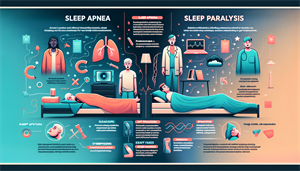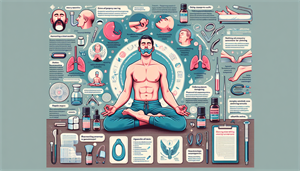
Sleep Apnea and Sleep Paralysis
In the silent hours of the night, millions of people around the world grapple with two unusual yet pervasive sleep disorders: sleep apnea and sleep paralysis.
Despite their distinct manifestations, these conditions may be intertwined in ways we are just beginning to understand. They not only disrupt our sleep but can also profoundly impact our daily lives and overall well-being.
A journey through the realm of sleep science awaits us, ready to unravel the mysteries of these sleep disturbances and guide us towards a night of peaceful slumber.
Key Takeaways
Sleep apnea and paralysis are complex conditions with a high rate of comorbidity, and treatments for apnea may reduce paralysis episodes, highlighting their interconnected nature. Symptoms of sleep apnea include snoring, gasping for air, and excessive daytime sleepiness, and sleep paralysis presents as temporary immobility and hallucinations during REM sleep.
Effective management strategies for improving sleep health and treating both conditions involve lifestyle changes, good sleep hygiene, and medical interventions such as CPAP therapy.
Exploring the Intersection of Sleep Apnea and Sleep Paralysis
Sleep apnea and sleep paralysis are not just mere interruptions in our sleep; they are complex conditions that can potentially harm our health and quality of life.
Sleep apnea, characterized by interrupted breathing during sleep, can lead to chronic sleep deprivation and other health issues. On the other hand, sleep paralysis, defined by temporary immobility and distressing hallucinations during sleep, can evoke feelings of intense fear and helplessness. What if these two seemingly distinct sleep disorders were somehow connected?
A growing body of research suggests that this might be the case, indicating a possible link between apnea and sleep paralysis as a combined sleep disorder.
Symptoms of sleep apnea can exacerbate sleep paralysis episodes, suggesting a possible link between these two sleep disorders. This connection is supported by a higher prevalence of sleep paralysis among those with sleep apnea compared with the general population. Moreover, treatments for sleep apnea have shown potential in reducing sleep paralysis episodes, emphasizing the interconnectedness of these conditions. Therefore, gaining a deeper understanding of these sleep disorders and how they interact is of utmost importance.
The Nature of Sleep Apnea
Obstructive sleep apnea, the predominant form of sleep apnea, is characterized by intermittent closure of the airway during sleep. This can lead to episodes of sleep paralysis, making individuals feel helpless and terrified.
Conditions that obstruct airflow through the upper airways during sleep, such as the backward movement of the tongue or excessive weight and obesity, are the main factors contributing to sleep apnea. Identifying these factors is key for precise diagnosis and successful treatment.
Diagnosis of sleep apnea involves evaluation of symptoms and sleep history by a healthcare provider, who may also conduct a sleep apnea test known as a polysomnogram (PSG). Untreated sleep apnea can result in chronic sleep deprivation and various mental and physical health complications. Hence, early recognition of sleep apnea symptoms and seeking timely medical intervention is vital.
Understanding Sleep Paralysis Episodes
Sleep paralysis is a temporary condition characterized by the inability to move or speak during REM sleep, often accompanied by hallucinations and distressing emotions. Imagine waking up in the middle of the night, unable to move or speak, and experiencing intense hallucinations. This is the reality for individuals who experience sleep paralysis.
The symptoms can be distressing, including a feeling of being suffocated, as well as intense visual and sensory hallucinations that can evoke sensations of powerlessness and fear.


